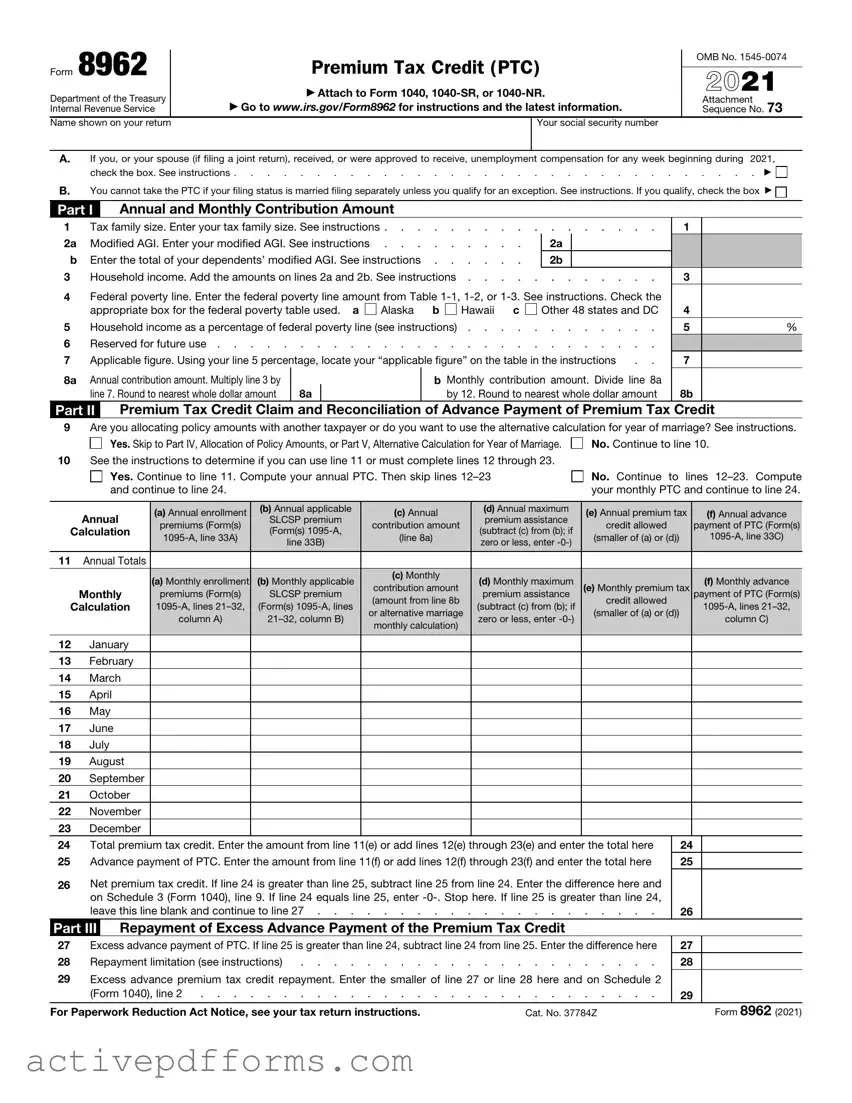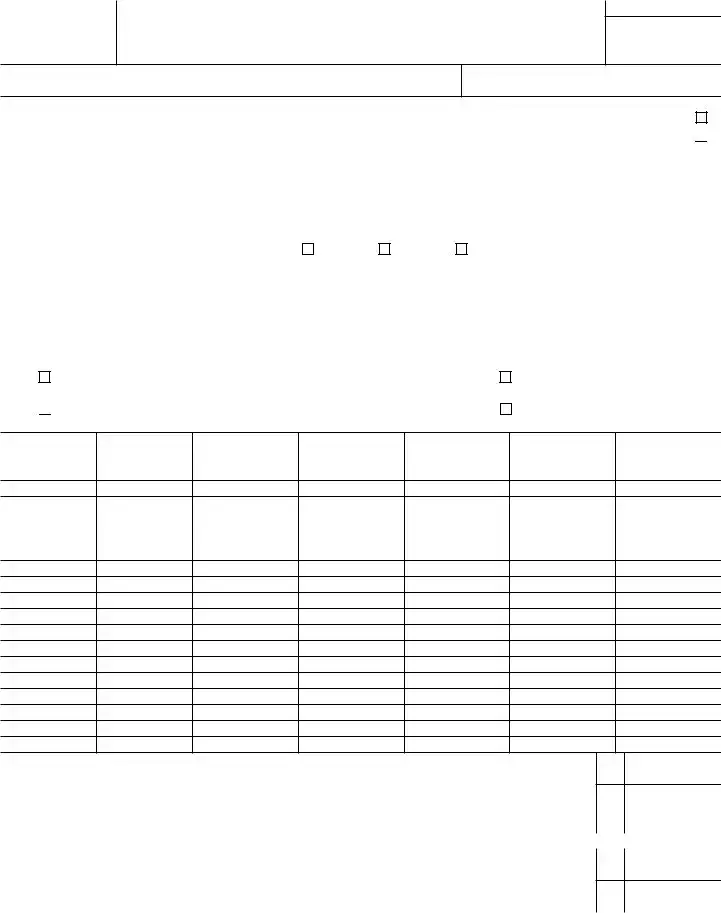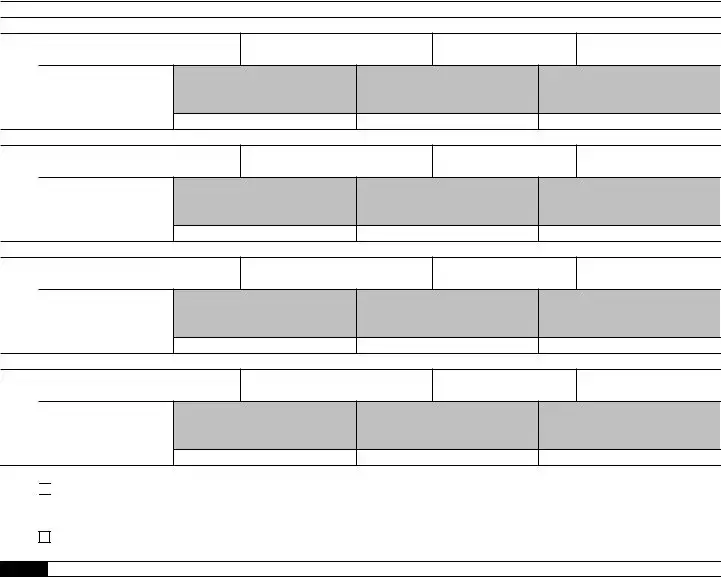Form 8962
Department of the Treasury Internal Revenue Service
Name shown on your return
Premium Tax Credit (PTC)
▶Attach to Form 1040, 1040-SR, or 1040-NR.
▶Go to www.irs.gov/Form8962 for instructions and the latest information.
Your social security number
OMB No. 1545-0074
2021
Attachment Sequence No. 73
A.If you, or your spouse (if filing a joint return), received, or were approved to receive, unemployment compensation for any week beginning during 2021,
check the box. See instructions . . . . . . . . . . . . . . . . . . . . . . . . . . . . . . . . ▶
B.You cannot take the PTC if your filing status is married filing separately unless you qualify for an exception. See instructions. If you qualify, check the box ▶ 

|
|
|
|
|
|
|
|
|
|
|
|
|
Part I |
Annual and Monthly Contribution Amount |
|
|
|
|
|
|
|
1 |
Tax family size. Enter your tax family size. See instructions |
1 |
|
|
2a |
Modified AGI. Enter your modified AGI. See instructions . . . |
. |
. . . . . |
2a |
|
|
|
|
b |
Enter the total of your dependents’ modified AGI. See instructions |
. |
. . . . . |
2b |
|
|
|
|
3 |
Household income. Add the amounts on lines 2a and 2b. See instructions |
3 |
|
|
4 |
Federal poverty line. Enter the federal poverty line amount from Table 1-1, 1-2, or 1-3. See instructions. Check the |
|
|
|
|
appropriate box for the federal poverty table used. a |
Alaska |
b |
Hawaii c |
Other 48 states and DC |
4 |
|
|
5 |
Household income as a percentage of federal poverty line (see instructions) |
5 |
|
% |
6 |
Reserved for future use |
|
|
|
7 |
Applicable figure. Using your line 5 percentage, locate your “applicable figure” on the table in the instructions . . |
7 |
|
|
8a |
Annual contribution amount. Multiply line 3 by |
8a |
|
|
b Monthly contribution amount. Divide line 8a |
8b |
|
|
|
line 7. Round to nearest whole dollar amount |
|
|
|
by 12. Round to nearest whole dollar amount |
|
|
Part II |
Premium Tax Credit Claim |
and |
Reconciliation |
of Advance Payment of Premium Tax Credit |
|
9Are you allocating policy amounts with another taxpayer or do you want to use the alternative calculation for year of marriage? See instructions.
Yes. Skip to Part IV, Allocation of Policy Amounts, or Part V, Alternative Calculation for Year of Marriage. |
No. Continue to line 10. |
10See the instructions to determine if you can use line 11 or must complete lines 12 through 23.
 Yes. Continue to line 11. Compute your annual PTC. Then skip lines 12–23 and continue to line 24.
Yes. Continue to line 11. Compute your annual PTC. Then skip lines 12–23 and continue to line 24.
No. Continue to lines 12–23. Compute your monthly PTC and continue to line 24.
|
Annual |
(a) Annual enrollment |
(b) Annual applicable |
(c) Annual |
(d) Annual maximum |
(e) Annual premium tax |
(f) Annual advance |
|
SLCSP premium |
premium assistance |
|
premiums (Form(s) |
contribution amount |
credit allowed |
payment of PTC (Form(s) |
|
Calculation |
(Form(s) 1095-A, |
(subtract (c) from (b); if |
|
1095-A, line 33A) |
(line 8a) |
(smaller of (a) or (d)) |
1095-A, line 33C) |
|
|
line 33B) |
zero or less, enter -0-) |
|
|
|
|
|
|
|
|
|
|
|
|
|
|
11Annual Totals
|
|
(a) Monthly enrollment |
(b) Monthly applicable |
(c) Monthly |
(d) Monthly maximum |
|
(f) Monthly advance |
|
|
contribution amount |
(e) Monthly premium tax |
|
Monthly |
premiums (Form(s) |
SLCSP premium |
premium assistance |
payment of PTC (Form(s) |
|
Calculation |
1095-A, lines 21–32, |
(Form(s) 1095-A, lines |
(amount from line 8b |
(subtract (c) from (b); if |
credit allowed |
1095-A, lines 21–32, |
|
or alternative marriage |
(smaller of (a) or (d)) |
|
|
column A) |
21–32, column B) |
zero or less, enter -0-) |
column C) |
|
|
monthly calculation) |
|
|
|
|
|
|
|
|
|
|
|
|
|
|
|
|
12January
13February
14March
15April
16May
17June
18July
19August
20September
21October
22November
23December
24 |
Total premium tax credit. Enter the amount from line 11(e) or add lines 12(e) through 23(e) and enter the total here |
24 |
25 |
Advance payment of PTC. Enter the amount from line 11(f) or add lines 12(f) through 23(f) and enter the total here |
25 |
26Net premium tax credit. If line 24 is greater than line 25, subtract line 25 from line 24. Enter the difference here and on Schedule 3 (Form 1040), line 9. If line 24 equals line 25, enter -0-. Stop here. If line 25 is greater than line 24,
|
|
|
|
|
leave this line blank and continue to line 27 |
26 |
Part III |
Repayment of Excess Advance Payment of the Premium Tax Credit |
|
27 |
Excess advance payment of PTC. If line 25 is greater than line 24, subtract line 24 from line 25. Enter the difference here |
27 |
28 |
Repayment limitation (see instructions) |
28 |
29Excess advance premium tax credit repayment. Enter the smaller of line 27 or line 28 here and on Schedule 2
(Form 1040), line 2 |
29 |
For Paperwork Reduction Act Notice, see your tax return instructions. |
Cat. No. 37784Z |
Form 8962 (2021) |
Form 8962 (2021) |
Page 2 |
Part IV |
Allocation of Policy Amounts |
|
Complete the following information for up to four policy amount allocations. See instructions for allocation details.
Allocation 1
30(a) Policy Number (Form 1095-A, line 2)
(c)Allocation start month
Allocation percentage applied to monthly amounts
(g)Advance Payment of the PTC Percentage
31(a) Policy Number (Form 1095-A, line 2)
(c)Allocation start month
Allocation percentage applied to monthly amounts
(g)Advance Payment of the PTC Percentage
32(a) Policy Number (Form 1095-A, line 2)
(c)Allocation start month
Allocation percentage applied to monthly amounts
(g)Advance Payment of the PTC Percentage
33(a) Policy Number (Form 1095-A, line 2)
(c)Allocation start month
Allocation percentage applied to monthly amounts
(g)Advance Payment of the PTC Percentage
34Have you completed all policy amount allocations?

 Yes. Multiply the amounts on Form 1095-A by the allocation percentages entered by policy. Add all allocated policy amounts and non- allocated policy amounts from Forms 1095-A, if any, to compute a combined total for each month. Enter the combined total for each month on lines 12–23, columns (a), (b), and (f). Compute the amounts for lines 12–23, columns (c)–(e), and continue to line 24.
Yes. Multiply the amounts on Form 1095-A by the allocation percentages entered by policy. Add all allocated policy amounts and non- allocated policy amounts from Forms 1095-A, if any, to compute a combined total for each month. Enter the combined total for each month on lines 12–23, columns (a), (b), and (f). Compute the amounts for lines 12–23, columns (c)–(e), and continue to line 24.
No. See the instructions to report additional policy amount allocations.
Part V Alternative Calculation for Year of Marriage
Complete line(s) 35 and/or 36 to elect the alternative calculation for year of marriage. For eligibility to make the election, see the instructions for line 9. To complete line(s) 35 and/or 36 and compute the amounts for lines 12–23, see the instructions for this Part V.
35 |
Alternative entries |
(a) |
Alternative family size |
(b) Alternative monthly |
(c) |
Alternative start month |
(d) |
Alternative stop month |
|
|
contribution amount |
|
|
|
|
|
for your SSN |
|
|
|
|
|
|
|
|
|
|
|
|
|
|
|
|
|
|
|
|
|
|
|
36 |
Alternative entries |
(a) |
Alternative family size |
(b) Alternative monthly |
(c) |
Alternative start month |
(d) |
Alternative stop month |
|
|
contribution amount |
|
|
|
|
|
for your spouse’s |
|
|
|
|
|
|
|
|
|
|
|
|
|
|
|
SSN |
|
|
|
|
|
|
|
|
|
|
|
|
|
|
|
Form 8962 (2021) |







